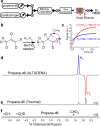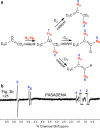Propane- d6 Heterogeneously Hyperpolarized by Parahydrogen
- PMID: 25506406
- PMCID: PMC4259496
- DOI: 10.1021/jp508719n
Propane- d6 Heterogeneously Hyperpolarized by Parahydrogen
Abstract
Long-lived spin states of hyperpolarized propane-d6 gas were demonstrated following pairwise addition of parahydrogen gas to propene-d6 using heterogeneous parahydrogen-induced polarization (HET-PHIP). Hyperpolarized molecules were synthesized using Rh/TiO2 solid catalyst with 1.6 nm Rh nanoparticles. Hyperpolarized (PH ∼ 1%) propane-d6 was detected at high magnetic field (9.4 T) spectroscopically and by high-resolution 3D gradient-echo MRI (4.7 T) as the gas flowed through the radiofrequency coil with a spatial and temporal resolution of 0.5 × 0.5 × 0.5 mm3 and 17.7 s, respectively. Stopped-flow hyperpolarized propane-d6 gas was also detected at 0.0475 T with an observed nuclear spin polarization of PH ∼ 0.1% and a relatively long lifetime with T1,eff = 6.0 ± 0.3 s. Importantly, it was shown that the hyperpolarized protons of the deuterated product obtained via pairwise parahydrogen addition could be detected directly at low magnetic field. Importantly, the relatively long low-field T1,eff of HP propane-d6 gas is not susceptible to paramagnetic impurities as tested by exposure to ∼0.2 atm oxygen. This long lifetime and nontoxic nature of propane gas could be useful for bioimaging applications including potentially pulmonary low-field MRI. The feasibility of high-resolution low-field 2D gradient-echo MRI was demonstrated with 0.88 × 0.88 mm2 spatial and ∼0.7 s temporal resolution, respectively, at 0.0475 T.
Figures







References
-
- Bouchard L. S.; Burt S. R.; Anwar M. S.; Kovtunov K. V.; Koptyug I. V.; Pines A. NMR Imaging of Catalytic Hydrogenation in Microreactors with the Use of Para-Hydrogen. Science 2008, 319, 442–445. - PubMed
-
- Lysova A. A.; Koptyug I. V. Magnetic Resonance Imaging Methods for in Situ Studies in Heterogeneous Catalysis. Chem. Soc. Rev. 2010, 39, 4585–4601. - PubMed
-
- Meersmann T.; Logan J. W.; Simonutti R.; Caldarelli S.; Comotti A.; Sozzani P.; Kaiser L. G.; Pines A. Exploring Single-File Diffusion in One-Dimensional Nanochannels by Laser-Polarized Xe-129 NMR Spectroscopy. J. Phys. Chem. A 2000, 104, 11665–11670.
-
- Koptyug I. V. MRI of Mass Transport in Porous Media: Drying and Sorption Processes. Prog. Nucl. Mag. Reson. Spectrosc. 2012, 65, 1–65. - PubMed
-
- Walker T. G.; Happer W. Spin-Exchange Optical Pumping of Noble-Gas Nuclei. Rev. Mod. Phys. 1997, 69, 629–642.
Grants and funding
LinkOut - more resources
Full Text Sources
Other Literature Sources
Research Materials
Miscellaneous
